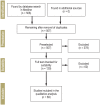Catheter-Associated Urinary Tract Infections in Adult Patients
- PMID: 32102727
- PMCID: PMC7075456
- DOI: 10.3238/arztebl.2020.0083
Catheter-Associated Urinary Tract Infections in Adult Patients
Abstract
Background: Urinary tract infections are among the more common types of nosocomial infection in Germany and are associated with catheters in more than 60% of cases. With increasing rates of antibiotic resistance worldwide, it is essential to distinguish catheter-associated asymptomatic bacteriuria from catheter-associated urinary tract infection (CA-UTI).
Methods: This review is based on publications from January 2000 to March 2019 that were retrieved by a selective search in Medline. Randomized clinical trials and systematic reviews in which the occurrence of CA-UTI in adult patients was a primary or secondary endpoint were included in the analysis. Two authors of this review, working independently, selected the publications and extracted the data.
Results: 508 studies were identified and 69 publications were selected for analysis by the prospectively defined criteria. The studies that were included dealt with the following topics: need for catheterization, duration of catheterization, type of catheter, infection prophylaxis, education programs, and multiple interventions. The duration of catheterization is a determinative risk factor for CA-UTI. The indications for catheterization should be carefully considered in each case, and the catheter should be left in place for the shortest possible time. The available data on antibiotic prophylaxis do not permit any definitive conclusion, but they do show a small benefit from antibiotic-impregnated catheters and from systemic antibiotic prophylaxis.
Conclusion: Various measures, including careful consideration of the indication for catheterization, leaving catheters in place for the shortest possible time, and the training of nursing personnel, can effectively lower the incidence of CA-UTI. The eous in some respects, and thus no recommendations can be given on certain questions relevant to CA-UTI.
Figures
Similar articles
-
Types of urethral catheters for management of short-term voiding problems in hospitalized adults: a short version Cochrane review.Neurourol Urodyn. 2008;27(8):738-46. doi: 10.1002/nau.20645. Neurourol Urodyn. 2008. PMID: 18951451 Review.
-
Catheter-Associated Urinary Tract Infections in the Adult Patient Group: A Qualitative Systematic Review on the Adopted Preventative and Interventional Protocols From the Literature.Cureus. 2021 Jul 9;13(7):e16284. doi: 10.7759/cureus.16284. eCollection 2021 Jul. Cureus. 2021. PMID: 34422457 Free PMC article. Review.
-
[Nocosomial urinary tract infections].Enferm Infecc Microbiol Clin. 2013 Nov;31(9):614-24. doi: 10.1016/j.eimc.2012.11.015. Epub 2013 Jan 31. Enferm Infecc Microbiol Clin. 2013. PMID: 23375744 Review. Spanish.
-
Nursing interventions to reduce the risk of catheter-associated urinary tract infection: part 2: staff education, monitoring, and care techniques.J Wound Ostomy Continence Nurs. 2009 Mar-Apr;36(2):137-54. doi: 10.1097/01.WON.0000347655.56851.04. J Wound Ostomy Continence Nurs. 2009. PMID: 19287262 Review.
-
Catheter associated urinary tract infection (CA-UTI) incidence in an Internal Medicine Ward of a Northern Italian Hospital.Infez Med. 2015 Sep;23(3):243-6. Infez Med. 2015. PMID: 26397293
Cited by
-
Combating Bacterial Biofilm Formation in Urinary Catheter by Green Silver Nanoparticle.Antibiotics (Basel). 2022 Apr 8;11(4):495. doi: 10.3390/antibiotics11040495. Antibiotics (Basel). 2022. PMID: 35453246 Free PMC article.
-
Risk factors for catheter-associated urinary tract infection in an intensive care unit: a matched case-control study.BMC Infect Dis. 2025 Apr 28;25(1):617. doi: 10.1186/s12879-025-10839-0. BMC Infect Dis. 2025. PMID: 40295958 Free PMC article.
-
[Analysis of epidemiological characteristics and risk factors of catheter-associated urinary tract infections in patients with perineal and/or hip burns].Zhonghua Shao Shang Yu Chuang Mian Xiu Fu Za Zhi. 2024 Mar 20;40(3):289-295. doi: 10.3760/cma.j.cn501225-20231027-00138. Zhonghua Shao Shang Yu Chuang Mian Xiu Fu Za Zhi. 2024. PMID: 38548400 Free PMC article. Chinese.
-
Application of enhanced recovery after surgery in partial nephrectomy for renal tumors: A systematic review and meta-analysis.Front Oncol. 2023 Feb 9;13:1049294. doi: 10.3389/fonc.2023.1049294. eCollection 2023. Front Oncol. 2023. PMID: 36845687 Free PMC article.
-
Early Removal of Indwelling Catheter and Vaginal Pack After Vaginal Prolapse Surgery: A Retrospective Cohort Study.Int Urogynecol J. 2024 Jul;35(7):1381-1387. doi: 10.1007/s00192-024-05815-2. Epub 2024 May 23. Int Urogynecol J. 2024. PMID: 38780626
References
-
- Warren JW, Platt R, Thomas RJ, Rosner B, Kass EH. Antibiotic irrigation and catheter-associated urinary-tract infections. N Engl J Med. 1978;299:570–573. - PubMed
-
- Nationales Referenzzentrum für Surveillance von nosokomialen Infektionen. Deutsche nationale Punkt-Prävalenzerhebung zu nosokomialen Infektionen und Antibiotika-Anwendung. 2016 Abschlussbericht. www.nrz-hygiene.de/fileadmin/nrz/download/pps2016/PPS_2016_Abschlussberi... (last accessed on 14 January 2020)
-
- Saint S, Chenoweth CE. Biofilms and catheter-associated urinary tract infections. Infect Dis Clin North Am. 2003;17:411–432. - PubMed
-
- Warren JW. Catheter-associated urinary tract infections. Int J Antimicrob Agents. 2001;17:299–303. - PubMed
-
- Bagshaw SM, Laupland KB. Epidemiology of intensive care unit-acquired urinary tract infections. Curr Opin Infect Dis. 2006;19:67–71. - PubMed
Publication types
MeSH terms
LinkOut - more resources
Full Text Sources
Medical


